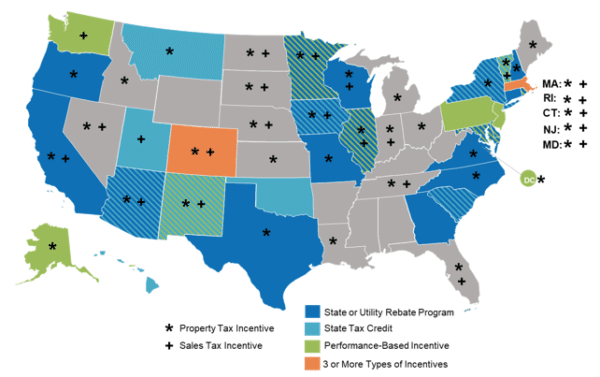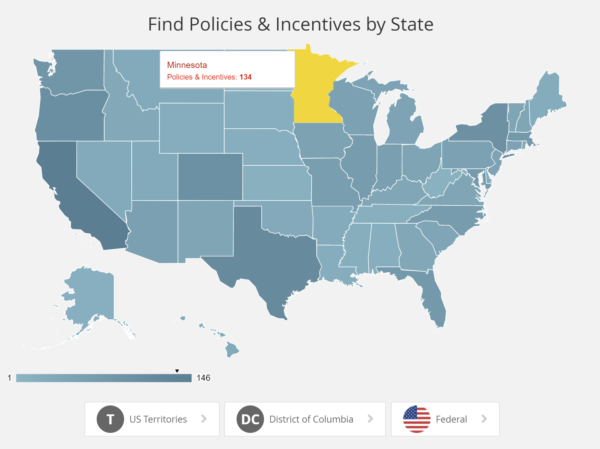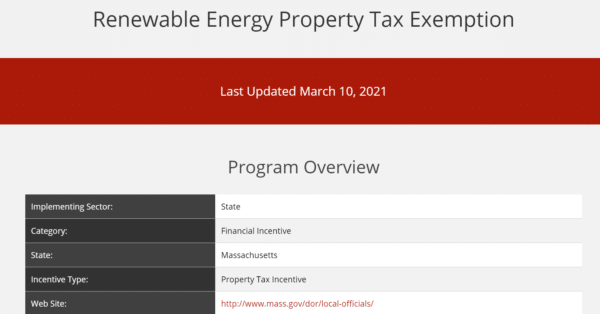The next step in our Solar 101 series is to look at state-level incentives that can make a big difference in your project’s financial prospects.
Multiple revenue streams affect the payback period of a solar power project. We’ve already discussed three of them: savings from electricity generation, federal tax credits, and net metering. Soon, we’ll show how these revenue streams combine to cover the $21,000 average cost of a solar power project.
If you live in a state without solar incentives, then this article might apply less to your project. For example, while California offers net metering and produces more solar electricity than any other state, it doesn’t offer a specific solar incentive. Similarly, there are no incentives offered by the “Sunshine State” of Florida, nor for the Longhorns down in Texas.

Image: Bill Onasill, Flickr
Those three states are the largest in the country, totaling 90 million of the 328 million people in the country, according to the U.S. Census website. If you’re one of those 90 million, you can still use the tools outlined in this article.
For example, many cities offer their own solar incentives and renewable energy loans, not to mention important legal protections. And of course, all states are still eligible for federal-level solar incentives.
You can explore the tools available in your home state several ways. The first – and most important – is to communicate with your contractor. Your contractor will know your incentives well, because it’s their job to show a project’s best financial return on investment.
A second tool – often challenging to navigate – is your electricity utility’s website. As you work through the installation process, you might have to access the website to download or submit documents. Reading through and interacting with your utility’s web resources is time well spent, as it provides valuable information about local laws and procedures. Keep in mind that some states, like Massachusetts, share their solar incentives on a government website instead of a power company website.
A third – and the best tool to learn about your state incentives, in this author’s opinion – is the Database of State Incentives for Renewables & Efficiency (DSIREusa.org). This is the same tool we used to research your state’s net metering laws.

The DSIRE team published a high level map above, along with an article that summarizes the many laws; however, because there are so many solar incentive laws around the country, it’s difficult to put all the information into one image.
Keeping that complexity in mind, let’s do a quick walkthrough on how to find the information that matters for your solar project.
- Visit the website https://www.dsireusa.org/ and click on your home state.
- On your state page, near the top, click on the “solar” link. This will filter the search results.
- Additional filtering:
- Set “Implementing Sector” to “State”
- Set “Eligible Sector” to “Residential”
- Double check that “Implementing Sector” isn’t hiding incentives in “Local” or “Utility”
Once these steps are complete, you should see a list of solar-focused incentives and laws that apply (mostly) to residential solar power. Clicking on these individual links will give you detailed information on the topics, including links to applicable legislation.

Take a moment to examine all of these incentives and laws thoroughly. Keep in mind that many of them are not standard “incentives.” For example, Massachusetts offers a “property tax exemption.” In Florida, homeowner associations may not stop you from installing solar power. And in Colorado, there’s no sales tax on residential renewable energy installations.

After you focus on solar related laws and incentives, return to step #1 (above), and browse through the energy related laws in your state. Some states offer electric vehicle incentives, heat pumps, lighting, efficiency, and other clean energy-related support.
And one final pitch for the DSIRE team. If you are a solar professional looking for a simple, centralized document of all laws related to solar, energy storage, and/or electric vehicles , check out the DSIRE Insight informational package. It is delivered in PDF and spreadsheet format that allows for fast browsing.
This content is protected by copyright and may not be reused. If you want to cooperate with us and would like to reuse some of our content, please contact: editors@pv-magazine.com.








By submitting this form you agree to pv magazine using your data for the purposes of publishing your comment.
Your personal data will only be disclosed or otherwise transmitted to third parties for the purposes of spam filtering or if this is necessary for technical maintenance of the website. Any other transfer to third parties will not take place unless this is justified on the basis of applicable data protection regulations or if pv magazine is legally obliged to do so.
You may revoke this consent at any time with effect for the future, in which case your personal data will be deleted immediately. Otherwise, your data will be deleted if pv magazine has processed your request or the purpose of data storage is fulfilled.
Further information on data privacy can be found in our Data Protection Policy.